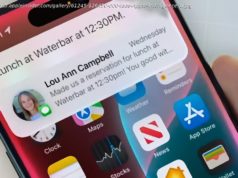As usual, Google is giving us an early look at the next version of Android – dubbed simply as Android P, for now – at Google I/O 2018. Set to be one of the most
As usual, Google is giving us an early look at the next version of Android – dubbed simply as Android P, for now – at Google I/O 2018. Set to be one of the most major updates to the OS yet, Android P brings quite a number of new features, including iPhone X -like gesture navigation.
Yeap, it appears Google is somewhat taking a page out of Apple’s book. Much like the iPhone X, users can use gestures to navigate around Android P. Instead of the familiar three-button navigation, the upcoming update will replace it with a single, oblong line.
Some actions are still familiar, of course. Tapping on the oblong line brings you back to the home screen, and a long press summons Google Assistant. However, to look at your recent apps, you’ll have to slide to the right. The back button, on the other hand, will only appear inside apps – it’s contextual now.
Interestingly, you can swipe all the way up to bring up the app drawer, and a half swipe up brings you to the new overview screen, which has apps you’ve recently opened. The difference here, of course, is the fact that apps in the overview page are interactive: you can actually select and copy text in these apps without leaving the screen. Pretty neat.
Aside from that, Android P will take advantage of AI to further improve your battery life. Yes, every version of Android promises better power efficiency, but Android P’s solution is quite interesting. By partnering with DeepMind – which is a part of Alphabet – devices running on Android P will take note of what apps you launch and when you launch them. It will then shut down apps in the background that you are not going to launch anytime soon.
DeepMind does the same thing with your brightness setting as well with “Adaptive Brightness.” Touted as a new feature for Android P, the OS can learn your usage habit and adjust your brightness settings accordingly. This, in turn, should reduce the amount of times you have to adjust your screen’s brightness manually.
Another notable feature introduced in Android P is the ability to monitor how much you use your phone. Done via the new Dashboard app, you can see how long you’ve been on your phone, how many notifications you’ve received, and even a pie chart illustrating how much time you spend on each app on your phone.
It’s great to know exactly how long you’ve used your phone, and Google has a pretty smart way to take advantage of these data: you can set a limit on your usage of each app. Say you set to use Instagram for only 60 minutes. Once the time is up, the app will be “paused.” The app’s icon will be greyed out in the home screen, and you cannot launch it anymore.
Of course, you can head back to Dashboard to “unpause” the app, but that defeats the whole purpose of the feature – to spend less time on your phone.
Android P brings major changes and features over its predecessor, and the public beta is available right now on 11 different phones. These include the Pixel and Pixel 2 devices, Sony Xperia XZ2, Xiaomi Mi Mix 2S, Nokia 7 Plus, Oppo R15 Pro, Vivo X21, Essential phone, and the yet to be released OnePlus 6.
(Source: The Verge)
Gamer, tech junkie, and an early adopter of way too many gadgets, Andrew hopes to drive the tech journalism industry in Malaysia to new heights.






